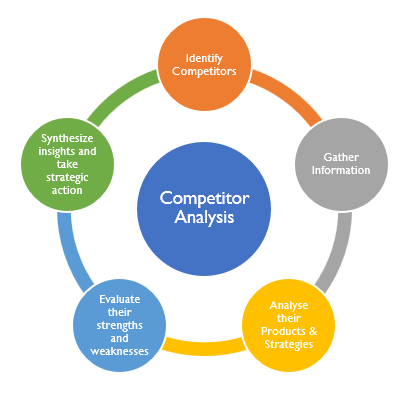In the constantly evolving world of business, staying ahead of your competition is not just strategy, it’s a necessity. This rings especially true for Product Managers, who sit at the heart of innovation, strategy, and execution. Through the lens of competitor analysis, we’ll uncover why this not only shapes the present but also dictates the future success of products. Let’s dive in, shall we?
Introduction
Imagine you’re a captain sailing the vast ocean. Without a map, compass, or stars to guide you, navigating through storms and reaching your destination becomes an insurmountable task. This is what the business landscape looks like without competitor analysis for a Product Manager. Competitor analysis isn’t just a task to check off; it’s an ongoing process that equips Product Managers with the insights needed to navigate the market’s choppy waters. In this article, we’ll explore the multifaceted role of competitor analysis in a Product Manager’s job, highlighting its criticality through detailed exploration and real-world relevance.
Understanding the What and Why of Competitor Analysis
The Essence of Competitor Analysis
- Definition and Scope: At its core, competitor analysis involves systematically evaluating your competitors’ products, strategies, and market performance. It’s about understanding their strengths, weaknesses, opportunities, and threats (SWOT analysis).
- Strategic Importance: The insights gleaned from this analysis inform strategic decisions, from product development and marketing to sales strategies and customer service improvements.
“Knowledge is power. And knowledge about your competition is Superpower.”
Why It’s Indispensable for Product Managers
- Market Positioning: Knowing where your product stands in comparison to others helps in crafting unique value propositions.
- Innovation Catalyst: By analyzing competitors, Product Managers can identify gaps in the market, inspiring innovation.
- Risk Mitigation: By anticipating competitor moves, companies can better prepare and respond, mitigating potential risks.
Unpacking the Process: How to Conduct Competitor Analysis Effectively

Key Steps in the Process
- Identify Your Competitors: Start with identifying direct and indirect competitors in your market segment.
- Gather Information: Utilize resources like company websites, customer reviews, and industry reports to collect data.
- Analyze Their Strategies and Products: Look at their product features, quality, pricing strategy, and marketing tactics.
- Evaluate Their Strengths and Weaknesses: Conduct a SWOT analysis for each key competitor.
- Synthesize Insights and Take Strategic Action: Based on the analysis, identify opportunities for your product and plan your strategy accordingly.
Tools and Techniques
- Utilize digital tools like SEMrush for SEO strategy analysis or Crunchbase for funding and corporate information.
- Conduct customer surveys and interviews to understand perceptions and preferences related to competitors’ products.
Real-World Applications and Success Stories
Adapting and Innovating: A Case Study
Imagine a scenario where a leading tech gadget manufacturer uses competitor analysis to uncover a gap in the market for durable, child-friendly tablets. By focusing on robustness and parental controls, they are able to capture a new market segment, showcasing the power of strategic competitor analysis.
A few more examples
Let me cover a few more examples below.
- Retail Industry: A retail company may analyze its competitors by visiting their stores, observing layout and merchandising strategies, pricing strategies, and customer service practices. They may also monitor competitors’ online presence, including their e-commerce platforms, social media activities, and customer reviews. For instance, a clothing retailer might regularly visit competitor stores to compare pricing, product selection, and store ambiance to identify areas for improvement.
- Technology Industry: In the tech industry, companies often conduct competitor analysis to understand product features, pricing models, and market positioning. For example, a smartphone manufacturer might analyze competitors’ product specifications, pricing tiers, and marketing strategies to identify opportunities to differentiate their own products and gain a competitive edge.
- Automotive Industry: Automotive companies conduct competitor analysis to stay informed about industry trends, consumer preferences, and new technologies. They may benchmark competitors’ vehicle performance, safety features, fuel efficiency, and pricing. For instance, a car manufacturer might analyze competitors’ marketing campaigns, customer feedback, and sales data to identify emerging trends and inform their product development and marketing strategies.
- Fast Food Industry: Fast-food chains often conduct competitor analysis to identify menu trends, pricing strategies, and promotional tactics. They may monitor competitors’ menu innovations, seasonal promotions, and advertising campaigns to stay competitive. For example, a fast-food restaurant might analyze competitors’ pricing on popular menu items, promotional offers, and customer loyalty programs to adjust their own pricing strategies and attract more customers.
- Financial Services Industry: Banks and financial institutions conduct competitor analysis to evaluate competitors’ product offerings, interest rates, fees, and customer service experiences. They may also analyze competitors’ digital banking features, mobile apps, and online account management capabilities. For instance, a bank might conduct mystery shopping exercises to compare the customer experience at different branches and identify areas for improvement.
These examples illustrate how competitor analysis is a multifaceted process that involves gathering information from various sources, including direct observation, market research, and data analysis, to gain insights into competitors’ strategies, strengths, and weaknesses. By understanding the competitive landscape, Product Managers can make informed decisions about their products to stay competitive and achieve their business objectives.
Staying Ahead of Trends
Product Managers should always be on the lookout for emerging trends within their competitors’ strategies. This foresight can lead to preemptive product updates or new feature development, keeping the product ahead of the curve.
Conclusion: Making Competitor Analysis an Integral Part of Your Strategy
In conclusion, competitor analysis is not just about keeping tabs on your rivals; it’s about understanding the market dynamics, identifying opportunities for innovation, and setting a strategic direction for your product. For Product Managers, this is not an optional task—it’s essential. By making competitor analysis an integral part of your strategy, you ensure that your product does not just meet the current market needs but is also geared for future success. Remember, in the race for market leadership, awareness is your best ally.
“By understanding the strengths and weaknesses of your competitors, you can not only anticipate their next moves but also strategically position your product to win the market.”
Engage in competitor analysis with curiosity, diligence, and the intent to innovate. Let it be the compass that guides your product strategy, ensuring that you not only navigate the present market successfully but also set sail for uncharted territories with confidence.



